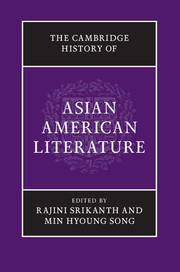
- Cited by 4
-
Cited byCrossref Citations
This Book has been cited by the following publications. This list is generated based on data provided by Crossref.
Chen, Tina 2017. The “Comfort” Of Critical Consolidation: Pedagogy, Ethical Alienation, and Asian American Literary Studies. American Literature, Vol. 89, Issue. 2, p. 331.
Baker, William 2018. XIXBibliography, Textual Criticism, and Reference Works. The Year's Work in English Studies, Vol. 97, Issue. 1, p. 1329.
Cummings, Ronald and Donnell, Alison 2020. Caribbean Literature in Transition, 1970–2020.
Lee, Sue-Im 2020. Can You Tell by Looking? A Postvisible Definition of Asian American Literature. American Literature, Vol. 92, Issue. 3, p. 543.
- Publisher:
- Cambridge University Press
- Online publication date:
- December 2015
- Print publication year:
- 2015
- Online ISBN:
- 9781107284289
- Subjects:
- Literature, Area Studies, American Literature, American Studies, Asian Literature, Asian Studies
- Collection:
- Cambridge Histories - Literature


